Harvey Davis comes to open the gate to his dusty, wind swept compound in the remote part of northern Namibia.
"Welcome, welcome, it's been so long since we've had visitors," he exclaims at the two health workers.
The 79-year-old summons his wife, Ruth Nasidengo, who is 40, from their home. She emerges with two babies, clinging to each arm.
This is the front line in Namibia's war against HIV, where a data-driven on-the-ground approach has helped it become one of the most successful countries in tackling its spread.
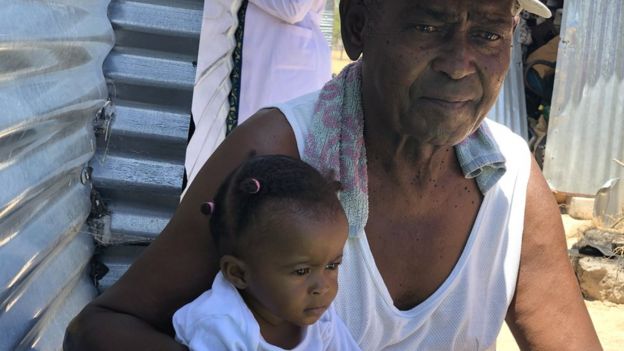
Harvey Davis was happy to be tested by the health workers
The red-uniformed health workers are field officers, who report to a troop commander, who in turn is under a division commander. Rather than guns, their weapons are a small plastic table and a cooler bag filled with ice packs and HIV tests.
Leontine Iipinge and Maria Johannes have walked more than 3km (2 miles) from their base in the Oshana region to visit the couple.
The initials TCE, meaning Total Control of Epidemic, stand out in bold letters on their shirts. It is a programme run by a national NGO, Development Aid from People to People (Dapp Namibia).
The field workers are two of more than 200 TCE health workers serving a population of nearly 182,000.
Mrs Nasidengo, a mother of twins, has been living with HIV for over a decade and has been a client of TCE for two years.
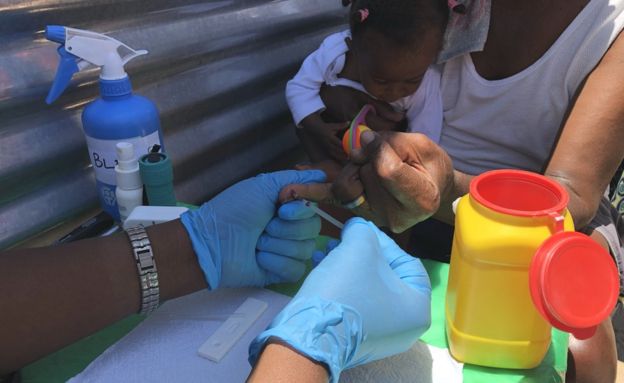
takes 15 minutes to get a result after the blood is taken
But this visit is about her husband as he is about to get his first home HIV test.
The ice packs in the cooler maintain the correct temperature for the rapid tests.
With his 11-month-old daughter, Dora, sitting on his lap Mr Davis watches as Ms Iipinge unpacks and disinfects her instruments and pricks his finger.
"I'm not worried," he quips, "but it sure looks like Dora is."
Detective work
As the 15 minutes tick by before the result is known, Ms Iipinge explains how testing the partners of people with HIV helps contain the spread of the virus.
Back at their base in Oshakati town, they compile data of all people known to be HIV-positive and then set about tracing their sexual partners to establish their HIV status.
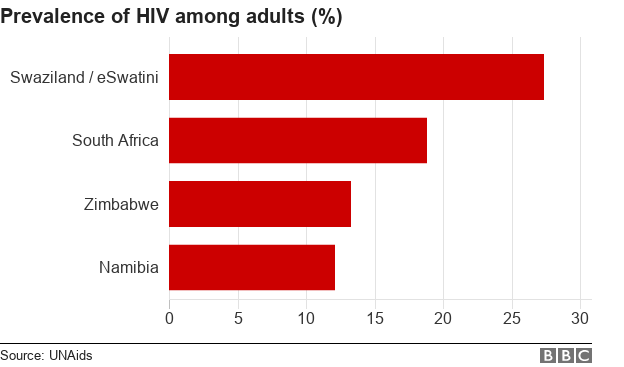
The rapid test looks for HIV antibodies in the blood and the results are indicated by stripes appearing in the window of the device.
As Mr Davis and his daughter watch, a single stripe appears showing that he is HIV-negative (two stripes indicates a positive result). But he is still referred to a hospital as he needs to be given drugs that reduce the risk of contracting the virus from someone who is HIV-positive by 90%.
TCE field officers have worked in this area for 14 years.
They have built community trust and respect but not everyone can be easily persuaded to take an HIV test.
The next stop for Ms Iipinge and Ms Johannes is about 12km away and they are heading to the home of Lucas Angula in the Evululuko township.
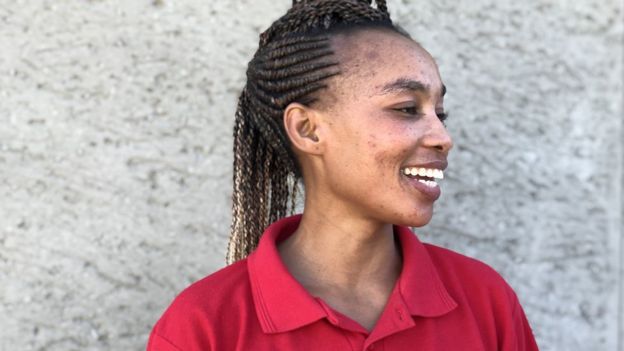
Maria Johannes says her HIV-prevention work is inspired by trying to improve the lives of Namibians
He found out that he was HIV-positive just last month, but it had taken his wife, Matilda Ipandula, 10 years to convince him to take the test:
'We would always fight and argue whenever I brought up the issue of HIV testing with my husband," she says.
"He refused to listen and that's why I asked our neighbour to get involved. It was difficult but it had to be done."
The neighbour, Emirita Kuutondokwa, now forms part of Mr Angula's trio, a support group made up of someone who is HIV-positive and two others.
He says their encouragement has helped him deal with his diagnosis and take the drugs that help contain the spread of the virus.
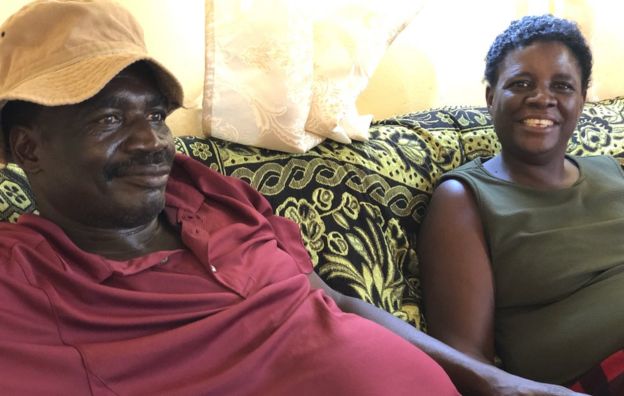
Lucas Angula (left) had to be persuaded to take the HIV test by his wife Matilda Ipandula (right)
Support is a key ingredient to the success in containing the spread of HIV here.
Close to Mr Angula's house, a small knot of people have gathered under a Marula fruit tree.
They are singing a song, in the Oshiwambo language, about how they are the lucky ones.
This is what is known as a Community Adherence Club - a group of 12 people who are all HIV-positive.
They take turns to collect medication from the clinic 20km away. This frees the remaining 11 to get on with other things and avoids clogging up the clinic.
'Not about the money'
After seeing to her clients, the division commander, Ms Johannes, joins the group to shake off the tension of the day as they dance around the tree.
"When you get into this, it's first about the job and the salary but as you stay it becomes about the people and the passion," she says.
"I've had field officers here who have only stayed for five months because they feel what they get as a salary does not compensate the time they spend at work but the ones that stay, they have passion to be with the people, to work with the people, to improve the lives of the people."
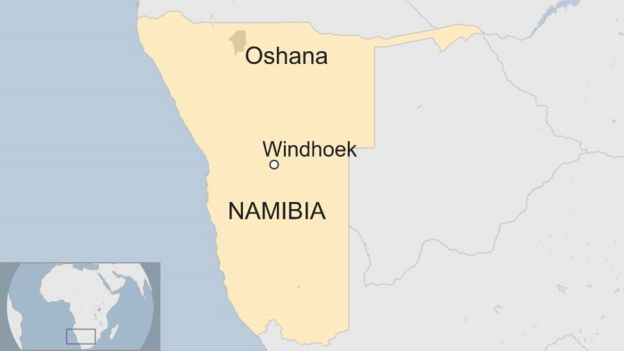
Newly released data by the US President's Emergency Plan for Aids Relief (Pepfar) shows it is this community-centred approach that has helped Namibia exceed some of the 90-90-90 targets set by UNAids in 2014.
The figures measure:
- The percentage of people who are thought to be HIV-positive who know their status
- The percentage of people who know their status who are taking antiretroviral drugs
- The percentage of people who are taking the drugs who have an undetectable level of HIV
For Namibia, the figures are 86%, 96% and 91% respectively.
'No time to relax'
Its neighbour, South Africa, the country with the highest number of HIV infections in the world, scores 90-68-78.
But Health Minister Dr Bernard Haufiku says now is not the time for complacency.
"There is a real possibility that we will be able to reach our target by the date set by UNAids [2020], we just have to give it a little bit of a push because we are almost there, just a few percentage left. We need to focus, especially on the prevention campaigns in the field, targeting young people that have not been tested."
Namibia used to have one of the highest HIV-prevalence rates in the world, but in the past 15 years, the number of new HIV infections has halved.
But the high infection rate among young women aged 15-24 continues to worry health officials here.
The health minister adds that on the 30th anniversary of World Aids Day, on Saturday, he will be encouraging young men to get tested and treated.
In Namibia, it seems to be the older generation, men like Mr Davis and Mr Angula, who are setting the example.
Ms Johannes hopes that at some point she will no longer have to deliver bad news to her clients.
"I remember there was a day in 2015," she says.
"My first six clients of the day all tested positive. Telling six people they're HIV-positive, without a break… it's a day I'll never forget."
Latest Stories
-
Chief Moomen to unveil Mansa Musa Epic Theater
22 minutes -
Academic City is chartered: Redefining tertiary education in Africa takes full force
27 minutes -
Financing challenges to remain in Ghana, Zambia – Fitch
38 minutes -
GUSA president calls for government aid amid funding crisis
48 minutes -
Cote d’Ivoire gets state of the art Technical Centre thanks to FIFA Forward
1 hour -
Kwasi Kwarteng: Exposing the inconsistencies in NDC’s promise on no academic fees for first-year students
2 hours -
NDC begins interview for MMDCE aspirants in Ashanti Region
2 hours -
Government to release feeding funds for 31 days to senior high schools – CHASS
2 hours -
Tap into reserves for debt repayment amid growing international pressure – Prof Peprah to gov’t
2 hours -
Police arrest 3 in connection with alleged cocoa bean smuggling
2 hours -
Ada Chiefs urge government to ensure safety of Electrochem workers
3 hours -
Local assembly elections must be partisan, current system hasn’t worked for 32 years – IDEG
3 hours -
A Country Called Ghana: Lilwin reveals he paid Ramzy Noah over $40,000 for his role
3 hours -
GFA confirms imminent changes to Black Stars technical team
3 hours -
GCB Bank supports the attainment of 5-Ps of Sustainable Development – MD at New Year School
3 hours

